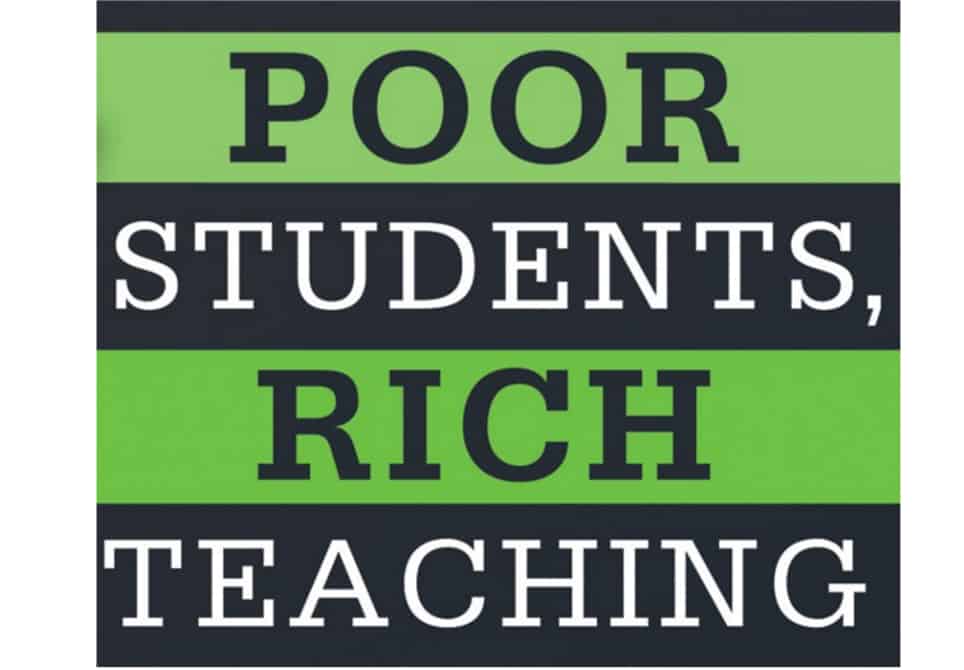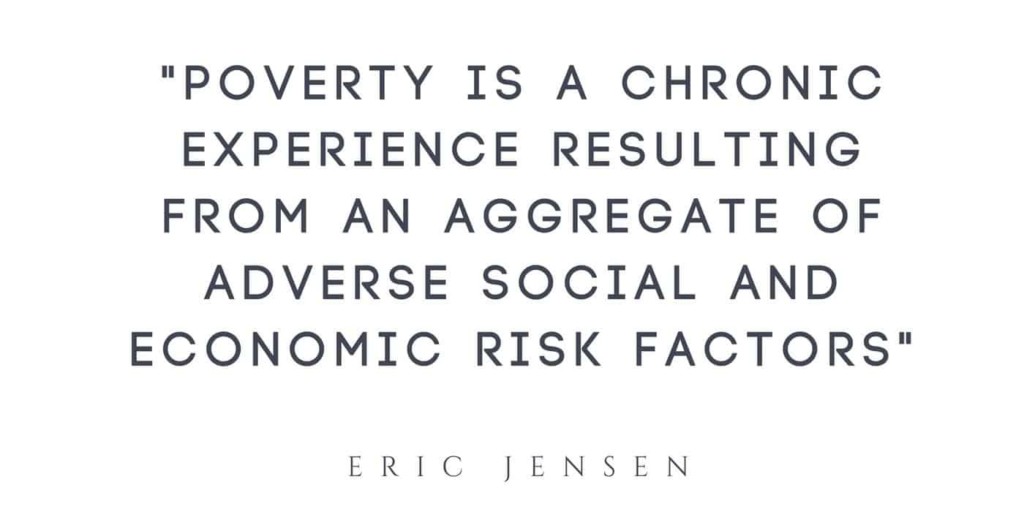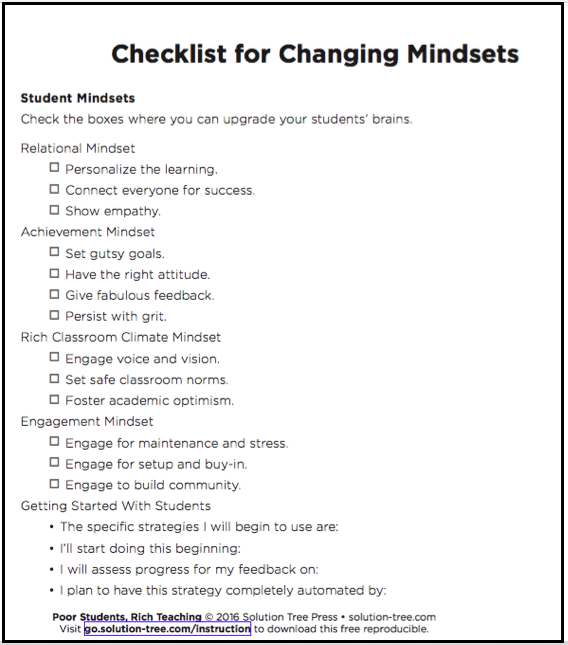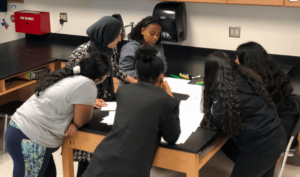Equitable Education for Students in Poverty Starts with the Teacher

You likely have read statistics and heard of the major challenge facing U.S. schools:
Over 51% of our students are considered “low-income” and these students tend to have lower levels of academic performance.
With a large focus on equity in education and trying to determining what processes and supports will help each individual reach their potential, the challenge to address the educational inequities in the U.S. and students in poverty is consistently an issue of debate. While large, systemic inequities loom, many teachers still enter classrooms every day asking:
How can we change the system to better serve all students? How do we help students in poverty? What do we give each student to help? What can I do?
A more promising message that you may not have heard is that while it is pervasive and does affect the brain & learning, poverty is NOT a culture and the effects can be mitigated over time with the right supports.
Therefore, one of the best things we can give to students is a teacher who has a deeper understanding of poverty, one who does not view students from a deficit lens and who works to understand what they can do to help.
An Honest Look at Poverty
Poverty is not just about being poor financially and living below the national income line, it is when someone is experiencing 3-8 risk factors (job loss, bankruptcy, divorce, etc.). Eric Jensen, an acclaimed brain researcher and educator, provides his definition in Poor Students, Rich Teaching:

So why does this matter? Why do we need to move beyond the stereotypical definition and realize there are a variety of social and economic risk factors that could be at play?
These chronic experiences can lead to stress, cognitive gaps and less emotional support. As a result, students may come to school tired and hungry, be assertive in their behavior and unwilling to follow along, seem disengaged or emotionally distraught – possibly dealing with difficult emotional issues by themselves. It is these behaviors and indicators that educators are often left to navigate, in addition to trying to support students academically.
As an educator in the U.S., it is very possible every morning you face a class where half (or more) of your students are living with a myriad of these different factors. Just knowing they are living in poverty and below the national income lines (something educators cannot control) doesn’t help decide how to teach to them or in trying to figure out what these students need.
What does help is a focus on understanding poverty. Jensen shares three key points that are essential to understanding poverty:
- Poverty is far more prevalent than one may think and the devastating effects are accelerating.
- It affects both educators and students in the classroom.
- Because brains can change, educators can reverse the academic effects of poverty and help students graduate college or career ready.
Number three is an extremely important understanding. Many well-intentioned teachers, often those that are at schools with a larger percentage of students living in poverty for all of the right reasons, approach students thinking that poverty IS a culture, that it is something stagnant and never-changing. Using a deficit lens to frame a student does not serve them well. This often leads to misunderstanding about the intelligence of a student and can lead to labeling or not truly pushing a student to reach his/her potential. This message is in support of educators and others looking to support these students–because you are more important than ever.
What Does This Mean for Teachers?
As stated in the opening of this post, poverty is NOT a culture and the effects can be mitigated over time with the right supports. But what are those supports and what can teachers do? More and more research is continuing to reveal to us evidence about the brain and how it can change when put into positive situations where teachers intentionally are addressing the issue head-on.
For example, we know that chronic stress shrinks the hippocampus (a key to memory, often one factor tied to academic performance), but supportive relationships heal it. We know IQ can be affected by your environment (which when in a negative environment can be detrimental), but we also know that it can be changed when given the right environmental factors. IQ is not fixed.
Teachers who acknowledge and address these additional adverse social and economic risk factors can truly change the lives of students. We know the teacher has one of the greatest effects on student outcomes, including when working with students in poverty. Above-average teachers (those who get one and a half years or more of a student gains per school year) can erase some of the effects of poverty in five years.
Teacher estimates of achievement are the highest-impact influence on student learning and achievement. If a teacher is unaware that a student in poverty, a student who may enter his or her classroom behind a grade-level, truly can grow their brain and achieve at the same as his/her counterparts, that teachers lower expectations truly could be damaging. The counter, a teacher who understands what poverty means and sets the right expectations, will have a greater chance at seeing students thrive.
We also know poverty can affect classroom engagement and students can seem ambivalent about learning or less prepared for the day. However, there are strategies to shift this from low engagement to a rich classroom culture with high-involvement. Further, students in poverty offered strong emotional support CAN perform equal to their higher-income peers.
Lastly, we know the right mindsets make a difference. A growth mindset, both for teachers and students in which they do not view intelligence and ability is not seen as set or fixed, has shown to have positive effects. In a recent research study on 10th-grade students in Chile, having a growth mindset was shown to “to serve as a buffer against the negative effects of poverty on achievement.”
Any teacher who currently, or eventually will, works with students in poverty needs to understand these positive effects that they can have. All too often teachers are faced with new initiatives and demand to use particular strategies aimed at helping them to work with students in poverty. While good intentioned, teachers often end up feeling they have more work and not always feeling it is helping them address the real issues at hand. A teacher may already know the possible impacts of poverty and understand what it means for his/her students, but not know what to actually do.
Jensen, who had a childhood filled with adversity and obstacles and went on to be a teacher (and still is working in high-poverty schools to this day), knows that feeling and has determined tangible strategies for teachers. He believes one place educators ought to start is by changing mindsets. It is a result of this work – changing mindsets (both educators and students), that he has seen true, long-lasting impactful progress. Incorporating the work of others, like Dweck & Tough, Jensen proposes 4 mindsets for change to help students succeed:
- Relational Mindset – Why the types of relationships you have (or don’t have) with students are one of the biggest reasons that students graduate (or dropout).
- Achievement Mindset – Why your attitude about success will make or break students from poverty.
- Rich Classroom Culture Mindset – Why a rich, energetic, high-performing class culture will transform your teaching and student responses.
- Engagement Mindset – Why engaging students will change their mindsets about participation, learning and success.
In order to shift student mindsets, there are practices and strategies, such as including gutsy goals, persisting with grit, showing empathy and engaging student voice that Jensen encourages teachers to employ on a daily basis. These shifts aren’t easy, take time & intention – but can be transformative. Additional mindsets specific for teachers – positivity, enrichment and graduation mindsets – are discussed in Jensen’s forthcoming book; Poor Students, Richer Teaching.
Example from Poor Students, Rich Teaching:

A Call to Us All
Arguably the most important message, one that should be uplifting, is that teachers who make the choice to better understand poverty and work to change mindsets (both theirs and their students) can be one, if not the biggest factor in making a difference.
“You are teaching the next generation that will be taking over the United States soon. There are twenty-six million K-12 students (out of fifty-one million total) from poverty in public schools. This is the next generation. They will either become ground-breaking scientists, better politicians, great teachers, wiser CEOs, and savvy inventors who change the world, or they will drop out, stay in poverty, and drain the economy by consuming services instead of paying taxes. It is your choice; what kind of country do you want to live in? Remember, classroom teachers (you) are the single biggest influences on student chances for graduation.”
~ Eric Jensen
We know from brain research and from student outcomes when they are in classrooms where teachers understand poverty, that poverty does not have to be a limiter in the success of our next generation. Albeit systemic educational inequities that continue to exist, we must start directly addressing the issue of poverty in our classrooms. If we aim to provide equitable education for all of our students, we also cannot assume students experience poverty in the same – or equal – ways. We must learn where they start to help pave the best path forward for them. The choice is ours to change our own mindsets and do the work.
For more from Eric Jensen, visit Solution Tree to get a copy of Poor Students, Rich Teaching and Poor Students, Richer Teaching.
For more, see:
- 7 Ways Smart Cities Attack Poverty
- Does Your Curriculum Have A Growth Mindset?
- Actionable Steps to Bring Growth Mindset Into the Classroom
Stay in-the-know with all things EdTech and innovations in learning by signing up to receive the weekly Smart Update. This post includes mentions of a Getting Smart partner. For a full list of partners, affiliate organizations and all other disclosures please see our Partner page.








0 Comments
Leave a Comment
Your email address will not be published. All fields are required.